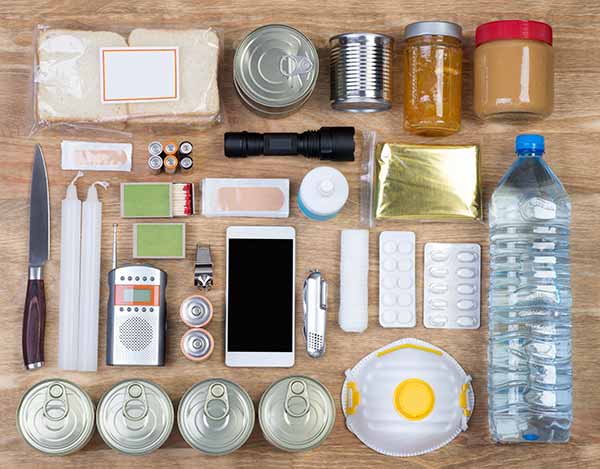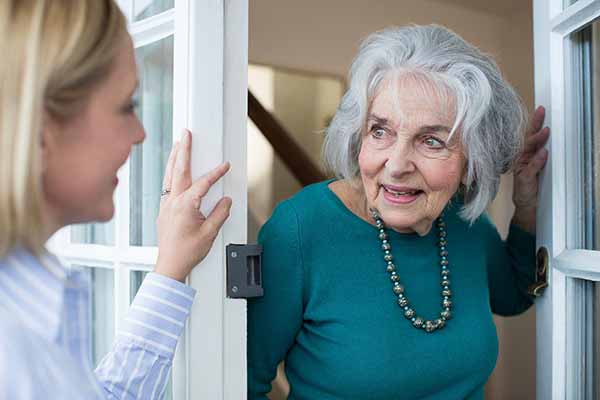Power outages can occur at any time and may last hours or even days. Extended outages can severely impact people, as Texas found out only too well in the winter of 2021.
Climate change means extreme weather events such as high winds, torrential rain, flooding, hurricanes, extreme temperatures, and wildfires are becoming more commonplace. All these episodes increase the risk of power outages. The United States is at medium-high risk of grid disruption, just one step from the highest alert level.
That’s why power outage preparedness pays; with a bit of forethought and planning, you and your loved ones can avoid the worst when a power outage strikes.
Emergency preparedness needn’t cost a fortune. Follow our guide to power outage preparedness, and you and your family members will be ready for when the lights go out.
What Is a Power Outage and Why Do They Happen?
A power outage is when the electrical power across a power grid stops working unexpectedly. Houses and buildings no longer have an electricity supply. A blackout is a long-term power loss while brownouts are sudden, temporary power losses that last minutes or a few hours.
There are many reasons power outages happen. The most common triggers are natural causes, human error, and grid overload. There are dozens of daily outages across the United States. The average American experienced eight hours of power outages in 2020.
Occasionally, extended power outages can endanger public safety, often occurring after natural disasters. Texas’ deadly winter storm in February 2021 left millions freezing and in the dark after several days without power, and hundreds lost their lives. The Red Cross provided emergency supplies of food and water.
An emergency preparedness kit and planning are essential. Follow our safety tips for peace of mind.
How Should I Prepare for a Power Outage?
Planning is the most critical part of power outage preparedness. Smartphones, laptops, and computers have limited use during extended power outages. Batteries run out of power, and the internet may not be available.
Information remains critical and you should be ready to adopt some old-fashioned methods. Make an emergency plan and ensure every household member understands all these steps.
With that in mind, keep a paper-copy list of contact information and vital records in a convenient and memorable location. Include:
- Telephone numbers for family members and friends
- Contacts for emergency services, hospitals, fire departments, police, and doctors
- Copies of important personal documents like birth certificates, insurance policies, medication, and house deeds
Remember that cordless phones won’t work without electricity; you’ll need a charged cell phone or a hardwired, single-line telephone to contact anyone.
Next, decide on a muster station for everyone to meet. Discuss how you’ll contact each other in case of an emergency. It’s good practice to rehearse an evacuation plan.
First aid training is always beneficial, and remember you may be required to help your neighbors. Factor their needs into your planning.
Research potential natural disasters in your area and plan accordingly. Surviving a freezing winter storm is distinct from a drought situation. For both scenarios, insulate your house properly so there are no air leaks.
Any household members with disabilities or medical needs may need to think carefully about arrangements — a power outage could mean life or death. Speak to your local authority or medical provider about medicine stockpiles and storage, especially if medicines need to be kept in the fridge. Find out how to manage critical drugs.
Electrically-powered medical equipment and medical devices won’t work during a power outage, so find out if there is a local center for emergency charging or use. Register anyone with medical needs with your utility company.
Stay alert to media notifications about possible extreme weather or other disruptions to power. Set your freezer to 0 degrees Fahrenheit (-17.7 Celsius) and your refrigerator at 40 degrees Fahrenheit (4.5 Celsius) or lower. Well-stocked fridges and freezers stay cooler, so fill any spaces with water bottles, ice cubes, and freeze gel packs for later use.
A good investment is surge suppressors for televisions, computers, and other electrical equipment. They protect your appliances from any power surges. Finally, install battery-powered carbon monoxide detectors throughout your home if you have a natural gas supply. Refrain from using candles during a power outage because of the fire risk.
What Emergency Supplies Do I Need for a Power Outage?
There are many items you will need to tough out a prolonged power outage. Life will be pretty elementary, so you need to think about the basics: warmth, food, water, and backup power.
Take into account every household member and all your pets — they’ll get hungry, too. You may not be able to travel, and gas stations may be closed, but keep your gas tank full. Here’s a guide to an emergency kit.
- One gallon of water per person, per day (up to two weeks’ supply)
- Nonperishable food that’s easy to prepare and clean dishes, e.g., canned vegetables or meats, granola, shelf-stable milk, crackers, peanut butter, pre-cooked grains and rice in pouches, and dried fruit
- Manual can opener
- Flashlight, headlamp, or lanterns with extra batteries or solar charging capabilities
- Hand-crank radio tuned to the National Oceanic and Atmospheric Administration (NOAA)
- First aid kit, including any required medicines
- Cell phones with backup, portable chargers (solar chargers are good if appropriate and usable)
- Personal hygiene items, including pre-moist wipes and hand sanitizer
- Multi-purpose tool that can switch off gas valves
- Water filter
- Face masks
- A whistle
- Glow sticks
- Extra clothing, hats, blankets, sleeping bags, and sleeping mats
- Garbage bags
- Fire extinguisher
- Thermometer to check food temperatures
- Coolers
- Cash
- Playing cards to pass the time, books, or other games you all enjoy
Work out how long your backup power will last, including batteries for flashlights. Do the same for food and water so you know how long you can last before you need to activate your evacuation plan.
Where Do I Store My Power Outage Emergency Supplies?
Everyone’s emergency kit will be slightly different, depending on where you live, whether it’s a city or rural dwelling, and climate.
It’s best to keep everything in weather-tight storage boxes in a dry, secure environment that can be easily reached in an emergency. No one should be clambering into a top-floor attic to get supplies during a hurricane.
What Should I Do When There Is a Power Outage?
We’ve looked at power outage preparedness. Now it’s time to look at what to do when the power goes out. You’ll feel much more confident and in control if you are well prepared, have rehearsed your power outage plan, and have tested your emergency preparedness.
You may not notice a power outage while you are asleep. If you wake and there is no power, call your utility company to report the outage. Daytime and evening power outages are more noticeable. With both, the recommended steps are:
- Turn off and unplug all electrical equipment, lights, and appliances.
- Leave one light bulb turned on, so you know when power returns.
- Turn off any natural gas equipment such as furnaces and stoves.
- Fill your bathtub or other storage vessels with water for later use.
- Travel only if strictly necessary.
- Check with neighbors if they have power and that they are okay.
- Leave utility crews to their work and don’t approach them; there may be dangerous power lines nearby.
- Check local news for updates. Long power outages may require water and food supply parcel deliveries that you don’t want to miss.
Remember, nearby houses may still have power because they are on a different grid circuit or because the problem affects only your home. Power outages of two hours don’t require much more work. However, if it lasts longer, you may need to take more steps.
Enter your ZIP Code and compare electricity rates
What About Fridge and Freezer Food During a Power Outage?
Power outages may lead to people staying at home for prolonged periods. Well-stocked fridges and freezers will keep food cold for a certain amount of time; some elementary food safety and hygiene knowledge will keep you right.
Thermometers will become vital to monitor food safety alongside appliance thermometers in your fridges and freezers.
Firstly, unplug any fridges and freezers. Move any fresh items that can be frozen from your fridge to your freezer so they last longer. Keep fridge and freezer doors closed as much as possible — a fridge stays cool for around four hours while a full freezer is cold for 48 hours if the doors remain closed. Resist the temptation to open freezer doors in sweltering temperatures, and the air conditioning isn’t working.
You can use any ice cubes or frozen water blocks in your freezer later for drinking water. Produce that won’t freeze should go into your coolers along with the frozen gel packs or excess ice from the freezer. This will keep food cold a little longer.
Food Safety: Cooking Food During a Power Outage
You must check the temperature of any food you will eat, especially if it has come from a warming fridge or freezer. Take special care with meat, fish, poultry, and dairy products. Throw any food with a strange odor, touch, or appearance.
You cannot cook or eat any food left above 40 degrees Fahrenheit (4.5 Celsius) for more than two hours; it must be discarded. Reduce this to one hour if temperatures are above 90 degrees Fahrenheit (32 degrees Celsius). Use a digital, quick-response thermometer to check the internal temperatures of food.
Use your thermometer to check if the food is thoroughly cooked before eating.
Take care with water, too, primarily if you exhaust your safe drinking water supply. Boil any water you intend to drink — you can sanitize pots and pans by boiling water in them for 15 minutes. Wash dishes and utensils with warm soapy water and keep countertops clean.
You can boil water during a power outage using a camp stove or grill, suspending a pot or kettle over a controlled outdoor fire or its hot coals, or using a fireplace or woodstove. Always exercise caution with open flames. Gas stoves can be lit with matches, but burners must be turned off immediately after boiling water.
Never use a grill or camp stove indoors for cooking, including in basements, garages, attics, or crawlspace.
How Can I Keep Warm During a Winter Power Outage?
Dressing in layers, wearing a hat, and keeping everyone together in a small room help keep people warm during power outages. Choose the warmest room in the house, ideally without exterior walls and drafts. Insulate the room with blankets and sheets over doorways and any windows — make it hard for heat to leave.
Scatter insulating materials on the floor, especially if it’s a wooden one. Mattresses are great to sit on, too. Don’t light candles or use any naked flames, and don’t use a gas stove or oven to heat your home. Ovens and stoves weren’t designed for heating and have no venting. That means carbon monoxide levels increase and could rise to dangerous levels with continued burning. You’ll feel warm close to the oven, but it won’t heat the house.
Setting up a tent within the room is a great way to add extra insulation. Move to a designated community center or emergency shelter if the temperatures drop too low.
Recommendations for Power Outage Preparedness in Summer
Heatwaves can cause power outages and bring distinct problems. Special advice for keeping cool during hot weather outages, when air conditioning won’t work, include:
- Double your water allowance to two gallons per water per day.
- Stay hydrated — no alcohol or caffeine — and drink liquids that replace electrolytes, like Gatorade.
- Open windows to allow breezes to drift through when it’s cooler outside than inside, usually in the mornings, evenings, and night time. Create cross breezes by opening windows at either end of your house.
- Close windows as soon as it’s warmer outside than inside, and draw curtains and blinds to reflect outside heat energy away from the interior.
- Stock battery- or solar-powered fans to blow warm out or draw cooler air into the home.
- Hanging a damp towel or placing a bucket of water in front of a fan creates a makeshift evaporative cooler.
- Wear loose, lightweight, cotton or linen clothing, with long-sleeved pants and shirts the best choices.
- Wear damp scarves around your neck and head.
- Stay in the shade. Building’s basements and ground floors tend to be the coolest areas. If you venture out into the sunshine, wear a hat and cover as much skin as possible.
- Damp sheets can help you sleep better during very hot spells.
- Eat potassium-rich foods like bananas, beans, cashews, and avocados.
- Avoid exercise and take things very easy.
Should I Use a Generator During a Power Outage?
Many people, particularly in rural areas, use generators for backup power. The U.S. Department of Energy stresses the importance of generator safety.
Firstly, ensure you have any required permits to use a generator, be sure you know how to use it, and keep it well maintained. Secondly, before use, disconnect your home from its standard power source. Otherwise, the electricity you generate may travel through wires and hurt utility workers trying to repair the power grid.
Place functioning portable generators outdoors; their exhaust fumes can cause fatal carbon monoxide poisoning if used indoors. Don’t leave them in garages with the garage door open because this will cause dangerous build-ups of carbon monoxide.
Make sure the generator is correctly grounded to avoid shocks, and only plug-in heavy-duty extension cords to the generator.
Never plug your generator into a wall socket or a home’s electrical system. Keep a decent fuel stock, not in the house, and never refuel your generator while it is running or still hot.
Generators can be significant assets during power outages, especially if you need to refrigerate medicines or operate medical devices. They require care, maintenance, and respect when in use. Natural gas, diesel, gasoline, and propane portable generators are available. Professional and licensed experts must install permanent backup generators.
Can I Use Solar Panels or Wind Turbines During a Power Outage?
Solar panels and wind turbines may continue to generate electricity during power outages, assuming favorable weather. However, you may not be able to use that electricity.
Check with your installer if you have a battery storage unit fitted. If yes, the battery unit will store the renewable energy created. You will have electrical power for as long as your battery lasts.
If you do not have a battery storage unit, your panels or turbines are tied into the power grid. They will shut down automatically during a power outage.
Can I Flush the Toilet if the Power Is Out?
You may have several flushes left in your toilet during a power outage. Gravity-flush toilets will refill while water remains available. However, water shortages are a common feature of power outages.
Water won’t refill the cistern forever because the central water system’s pumps will most likely stop working at some point. You will need to flush your toilet using buckets of water should this happen.
Can I Shower During a Power Outage?
You can shower during a power outage, with some caveats. It will be a cold shower if you have an electric or natural gas-powered shower. People with hot water tanks have some hot water in reserve, but once the hot water has gone, it’s gone.
Tanks may not refill if your home’s water supply is cut off. Water is a precious commodity during a power outage. It’s not recommended to empty your tank for a shower.
What Should You Not Do During a Power Outage?
The following is a handy recap of the points we’ve covered about what not to do during a power outage. Do not:
- Forget to check your emergency plan and follow it
- Light candles, camp stoves, grills, or use generators indoors, in garages, attics, or crawl spaces
- Run out of charge for cell phones
- Keep appliances plugged in
- Open the fridge and freezer door, or leave them half empty
- Leave the house unnecessarily, or panic-buy gasoline
- Connect a generator to the power grid or your home’s electrical circuit
- Eat unsafe food or unclean water
- Leave neighbors for long periods without checking on them
- Forget to plan for medical supplies and medical devices
What Should I Do Once the Power Returns?
You’ll know when power returns because the light bulb you left on will brighten. Turn back on the power supply and reconnect your devices and appliances. Charge cell phones and other emergency items, just in case the power goes once more.
Throw away any food exposed to high temperatures as defined earlier and discard any medication that hasn’t been kept properly. Check on your neighbors, and slowly return to everyday life.
Contact your insurance company if any damage has been caused during the power outage.
The Complete Guide to Ensure Power Outage Preparedness
Hopefully, you won’t need your power outage preparedness and emergency plans. However, it pays to be prepared, with extreme weather a more commonplace occurrence.
Get more helpful tips from our power outage guide, which complements this power outage preparedness guide. You can make lengthy power outages a more comfortable experience with some planning.
Get the whole household involved, and your biggest worry may be which card game to play.
Brought to you by energysavings.com
All images licensed from Adobe Stock.
Featured image:





